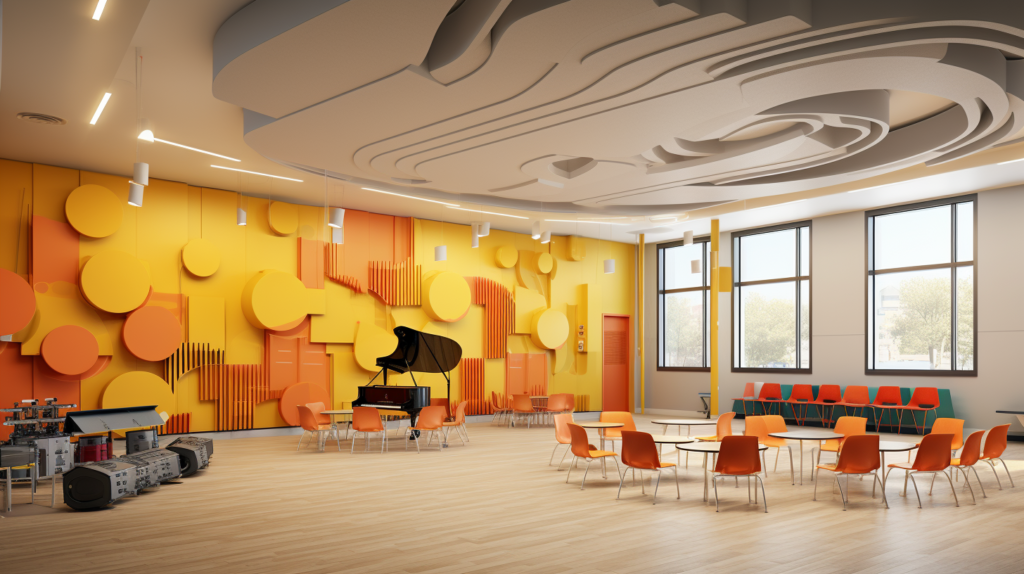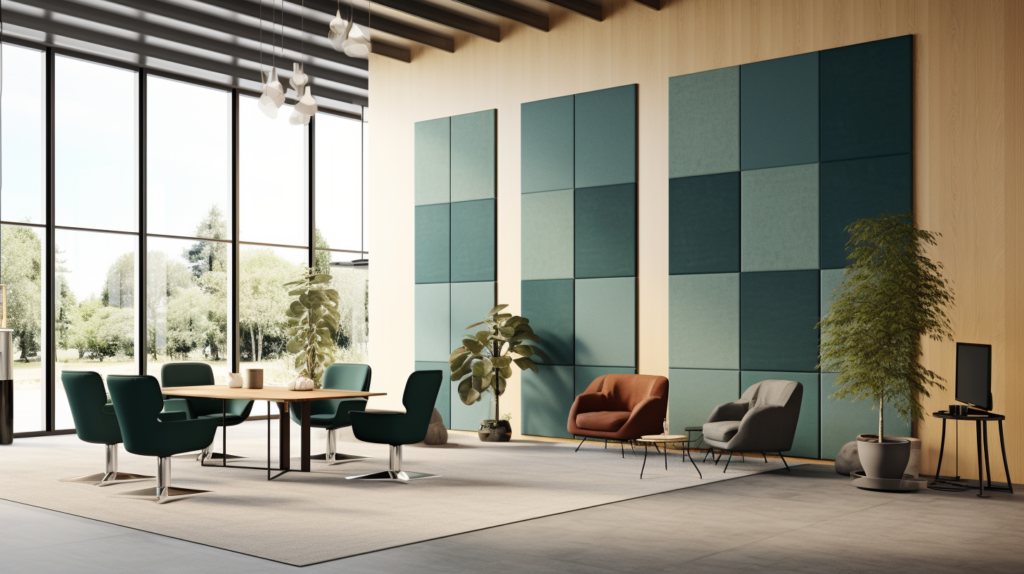Have you ever tried listening to a podcast or attending a virtual meeting in a noisy café?
How many times did you have to replay a segment or ask someone to repeat themselves? It’s frustrating, right?
Now, amplify that scenario: think of a classroom brimming with students eager to learn yet hindered by noise.
In the world of education, we often concentrate on the curriculum, teaching methodologies, and technological tools.
However, one factor that frequently gets relegated to the sidelines is the significance of classroom acoustics.
This oversight is not just a minor inconvenience; it’s a major impediment that disrupts both teaching and learning in significant ways.
In this comprehensive guide, we will unpack why acoustics are not just an add-on but a pivotal component of classroom design.
Specifically, we’ll examine how polyester acoustic panels can be game-changers in enhancing the educational experience. So, let’s dive right into this enlightening subject.
Why Are Acoustics Important in Classroom Learning?

The Overlooked Element of Classroom Design
Classrooms are often seen through a simplistic lens—as places where learning occurs.
This narrow view overlooks the multifaceted nature of classroom design, where every element, including acoustics, plays a vital role.
Acoustics can either make or break the learning environment, tipping the scales between an atmosphere of focus and a chaos of distractions.
The Impact on Teaching Effectiveness
When a classroom has poor acoustics, even the best teachers find it challenging to convey their lessons effectively.
Words get lost, instructions become unclear, and the teacher has to frequently repeat themselves.
This not only wastes valuable instructional time but also leads to teacher frustration, reducing the overall effectiveness of teaching.
Influencing Learning Outcomes
Poor acoustics don’t just affect teachers; they have a significant impact on students as well.
In a noisy classroom, students struggle to hear the teacher, understand the lesson, or even focus on their tasks.
This leads to lower engagement levels, reduced information retention, and ultimately, poorer academic performance.
The Benefits of Good Acoustics
On the flip side, a well-designed acoustic environment can do wonders for educational outcomes.
By reducing noise levels and enhancing speech intelligibility, good acoustics lower stress levels for both teachers and students.
This makes the teaching process more efficient and helps students focus better, leading to improved academic performance.
How Does Noise Negatively Affect Student Learning?

The Ubiquity of Noise
Noise is often dismissed as a mere annoyance, something we just have to “deal with.” However, in an educational setting, its detrimental impact is far-reaching.
From the buzzing of fluorescent lights to the chatter from an adjacent classroom, noise is a pervasive issue in schools that affects the quality of learning.
Impact on Cognitive Functions
Multiple studies have shown that noise pollution in classrooms does more than just cause irritation.
Noise interferes with the brain’s cognitive processing abilities, making it harder for students to concentrate, understand, and retain information.
It’s not just about the volume of the noise; even low-level but consistent noise can be disruptive enough to affect learning.
Academic Performance Takes a Hit
Research has consistently shown that students exposed to noisy learning environments perform worse in standardized tests compared to those in quieter settings.
This is not surprising given that noise affects memory retention and concentration, two critical factors for academic success.
This evidence emphasizes the urgent need for effective acoustic solutions in educational settings.
What Are the Common Acoustic Challenges in Traditional Classrooms?

The Echo Chamber Effect
Traditional classrooms are often architectural relics of a bygone era, designed with little consideration for acoustics.
Many of these spaces feature hard, reflective surfaces like concrete walls, tile floors, and even chalkboards.
These materials create an “echo chamber” effect, where sound waves bounce off the walls, leading to auditory distortions that can make comprehension difficult.
The Issue of Background Noise
But echoes are just one part of the problem. Traditional classrooms are often plagued by various sources of background noise.
This could be chatter from adjacent classrooms, noise from hallways, or even external disturbances like traffic and construction.
These noises, though seemingly minor, can accumulate to create a significant distraction, making it hard for students to focus on the lesson at hand.
The Toll on Teachers
The issue of poor acoustics doesn’t just impact students; it has a detrimental effect on teachers as well.
In a noisy classroom, teachers often have to raise their voices, sometimes to the point of shouting, to be heard.
Over time, this can lead to vocal strain, increased stress levels, and even long-term health issues, all of which can adversely affect the quality of teaching.
How Do Acoustic Panels Solve Classroom Noise Issues?

The Science of Sound Absorption
One of the most effective solutions for mitigating classroom noise is the installation of acoustic panels.
These panels are engineered to absorb sound waves, thus reducing echoes and lowering the overall noise levels in the room.
The science behind this is both simple and fascinating: the panels capture sound waves and convert the energy into a tiny amount of heat, effectively removing the sound from the environment.
The Case for Polyester Acoustic Panels
Among the various types of acoustic panels available, polyester acoustic panels stand out for several reasons.
Not only are they highly effective at absorbing sound, but they are also incredibly durable.
This makes them ideal for high-traffic areas like schools, where panels need to withstand the daily wear and tear.
Plus, polyester acoustic panels are made from recycled materials, adding an eco-friendly dimension to their appeal.
The Impact on Learning Environments
When acoustic panels are properly installed, the transformation of the classroom is remarkable.
The space changes from a cacophony of distracting noises to a quiet, focused learning environment.
Both teachers and students report feeling less stressed and more able to concentrate, leading to a more productive and effective educational experience.
What Are the Different Types of Acoustic Panels Available?

The Range of Options
When it comes to choosing acoustic panels, the market offers a range of options, each with its own set of advantages and disadvantages.
Foam panels and fabric-wrapped panels are common choices, known for their affordability and ease of installation.
Why Choose Polyester Acoustic Panels?
However, for durability, effectiveness, and aesthetic appeal, polyester acoustic panels are hard to beat.
Made from recycled materials, they are an eco-friendly choice that doesn’t compromise on performance.
They come in a variety of designs and colors, allowing for customization that can complement or even enhance the classroom décor.
Performance Across Frequencies
In terms of acoustic performance, polyester acoustic panels are highly efficient across a wide frequency range.
This means they can absorb a variety of noises, from the low-frequency hum of an air conditioner to the high-frequency chatter of students.
Such versatility makes them ideal for classrooms, where multiple types of noise can be present.
Conclusion
Classroom acoustics play an indispensable role in shaping the educational experience for both teachers and students.
The challenges posed by poor acoustics are not trivial; they have far-reaching implications for teaching efficacy and learning outcomes.
Acoustic panels, particularly those made from durable and effective polyester, offer a tangible solution to these challenges.
By investing in these panels, schools stand to gain long-term benefits that extend beyond mere noise reduction.
Improved focus, better academic performance, and enhanced well-being for both teachers and students make the investment in acoustic panels not just beneficial but essential.
Given the compelling evidence and the available solutions, the question isn’t whether we can afford to invest in classroom acoustics; it’s whether we can afford not to.
sFor those committed to providing the best educational experience, the choice is clear: invest in quality acoustic solutions today for a more focused, effective, and enriching learning environment tomorrow.
